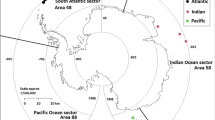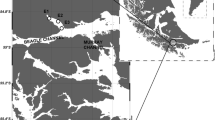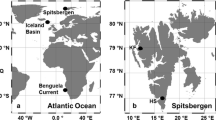Abstract
Fatty acid analysis for estimating dietary sources in marine predators is a powerful tool in food web research. However, questions have been raised about using fatty acids as dietary indicators from whole lipid samples, rather than from separate lipid classes. A drawback of scientific field-based studies is that samples are rarely collected over extended periods, precluding seasonal dietary comparisons. We used fisheries samples obtained over one year to investigate seasonal variations in the fatty acid composition of separated phospholipids and triacylglycerols of Antarctic krill (Euphausia superba). Seasonal variation was observed in fatty acid biomarkers within triacylglycerol and phospholipid fractions of krill. Fatty acids in krill triacylglycerols (thought to best represent recent diet), reflected omnivorous feeding with highest percentages of flagellate biomarkers (18:4n-3) in summer, and diatom biomarkers (16:1n-7c) in autumn, winter and spring. Carnivory biomarkers (∑ 20:1 + 22:1 and 18:1n-9c/18:1n-7c) in krill were higher in autumn. Phospholipid fatty acids were less variable and higher in 20:5n-3 and 22:6n-3, which are essential components of cell membranes. Sterol composition did not yield detailed dietary information, but percentages and quantities of cholesterol, the major krill sterol, were significantly higher in winter and spring compared with summer and autumn. Copepod markers ∑ 20:1 + 22:1 were not strongly associated with the triacylglycerol fraction during some seasons, and neither was 18:4n-3. Krill might mobilise 18:4n-3 from triacylglycerols to phospholipids for conversion to long-chain (≥ C20) polyunsaturated fatty acids, which would have implications for its role as a dietary biomarker. For the first time, we demonstrate the dynamic seasonal relationship between specific biomarkers and krill lipid classes.
Similar content being viewed by others
References
Alonzo F, Nicol S, Virtue P, Nichols PD (2003) Lipids as trophic markers in Antarctic krill, I. Validation under controlled laboratory conditions. In: Huiskes AHL, Gieskes WWC, Rozema J, Schorno RML, Vies SM, Wolff WJ (eds) Antarctic biology in a global context. Backhuys Publishers, Leiden, pp 121–128
Alonzo F, Virtue P, Nicol S, Nichols PD (2005a) Lipids as trophic markers in Antarctic krill. II. Lipid composition of the body and digestive gland of Euphausia superba in controlled conditions. Mar Ecol Prog Ser 296:65–79
Alonzo F, Virtue P, Nicol S, Nichols PD (2005b) Lipids as trophic markers in Antarctic krill. III. Temporal changes in digestive gland lipid composition of Euphausia superba in controlled conditions. Mar Ecol Prog Ser 296:81–91
Atkinson A, Meyer B, Stübing D, Hagen W, Schmidt K, Bathmann UV (2002) Feeding and energy budgets of Antarctic krill Euphausia superba at the onset of winter – II. Juveniles and adults. Limnol Oceanogr 47:953–966
Auerswald L, Meyer B, Teschke M, Hagen W, Kawaguchi S (2015) Physiological response of adult Antarctic krill, Euphausia superba, to long-term starvation. Polar Biol 38:763–780
Barrett S, Volkman J, Dunstan G (1995) Sterols in 14 species of marine diatoms (Bacillariophyta). J Phycol 31:360–369
Bell M, Dick J, Anderson T, Pond D (2007) Application of liposome and stable isotope tracer techniques to study polyunsaturated fatty acid biosynthesis in marine zooplankton. J Plankton Res 29:417–422
Bligh EG, Dyer W (1959) A rapid method of total lipid extraction and purification. Can J Biochem Physiol 37:911–917
Bottino NR (1974) The fatty acids of Antarctic phytoplankton and euphausiids. Fatty acid exchange among trophic levels of the Ross Sea. Mar Biol 27:197–204
Clarke A (1980) The biochemical composition of krill, Euphausia superba Dana, from South Georgia. J Exp Mar Bio Ecol 43:221–236
Clarke A (1984) Lipid content and composition of Antarctic krill, Euphausia superba Dana. J Crustac Biol 4:285–294
Dalsgaard J, St John M, Kattner G, Muller-Navarra D, Hagen W (2003) Fatty acid trophic markers in the pelagic marine environment. Adv Mar Biol 46:225–340
Ericson JA, Hellessey N, Nichols PD, Kawaguchi S, Nicol S, Hoem N, Virtue P (2018) Seasonal and interannual variations in the fatty acid composition of adult Euphausia superba Dana, 1850 (Euphausiacea) samples derived from the Scotia Sea krill fishery. J Crustac Biol. https://doi.org/10.1093/jcbiol/ruy032
Falk-Petersen S, Hagen W, Kattner G, Clarke A, Sargent J (2000) Lipids, trophic relationships, and biodiversity in Arctic and Antarctic krill. Can J Fish Aquat Sci 57:178–191
Fricke H, Gercken G, Schreiber W, Oehlenschlager J (1984) Lipid, sterol and fatty acid composition of Antarctic krill (Euphausia superba Dana). Lipids 19:821–827
Gigliotti JC, Davenport MP, Beamer SK, Tou JC, Jaczynski J (2011) Extraction and characterisation of lipids from Antarctic krill (Euphausia superba). Food Chem 125:1028–1036
Graeve M, Hagen W, Kattner G (1994) Herbivorous or omnivorous? On the significance of lipid compositions as trophic markers in Antarctic copepods. Deep Sea Res Part I Oceanogr Res Pap 41:915–924
Hagen W, Kattner G, Graeve M (1993) Calanoides acutus and Calanus propinquus, Antarctic copepods with different lipid storage modes via wax esters or triacylglycerols. Mar Ecol Prog Ser 97:135–142
Hagen W, Kattner G, Terbruggen A, Van Vleet ES (2001) Lipid metabolism of the Antarctic krill Euphausia superba and its ecological implications. Mar Biol 139:95–104
Hellessey N, Ericson JA, Nichols PD, Kawaguchi S, Nicol S, Hoem N, Virtue P (2018) Seasonal and interannual variation in the lipid content and composition of Euphausia superba Dana 1850 (Euphausiacea) samples derived from the Scotia Sea fishery. J Crustac Biol. https://doi.org/10.1093/jcbiol/ruy053
Ju S-J, Harvey HR (2004) Lipids as markers of nutritional condition and diet in the Antarctic krill Euphausia superba and Euphausia crystallorophias during austral winter. Deep Sea Res Part II Top Stud Oceanogr 51:2199–2214
Kanazawa A (2001) Sterols in marine invertebrates. Fish Sci 67:997–1007
Kattner G, Hagen W (1995) Polar herbivorous copepods – different pathways in lipid biosynthesis. ICES J Mar Sci 52:329–335
Kattner G, Hagen W (1998) Lipid metabolism of the Antarctic euphausiid Euphausia crystallorophias and its ecological implications. Mar Ecol Prog Ser 170:203–213
Kattner G, Hagen W, Lee RF, Campbell R, Deibel D, Falk-Petersen S, Graeve M, Hansen BW, Hirche HJ, Jónasdóttir SH, Madsen ML, Mayzaud P, Müller-Navarra D, Nichols PD, Paffenhöfer GA, Pond D, Saito H, Stübing D, Virtue P (2007) Perspectives on marine zooplankton lipids. Can J Fish Aquat Sci 64:1628–1639
Martin-Creuzburg D, von Elert E (2009) Ecological significance of sterols in aquatic food webs. In: Arts MT, Brett MT, Kainz M (eds) Lipids in Aquatic Ecosystems. Springer, New york, pp 43–64
Mayzaud P (1997) Spatial and life-cycle changes in lipid and fatty acid structure of the Antarctic euphausiid Euphausia superba. In: Valencia J, Walton DWH (eds) Antarctic communities: species, structure and survival. Cambridge University Press, Cambridge, pp 284–294
Mayzaud P, Albessard E, Cuzin-Roudy J (1998) Changes in lipid compostion of the Antarctic krill Euphausia superba in the Indian sector of the Antarctic ocean: influence of geographical location, sexual maturity stage and distribution among organs. Mar Ecol Prog Ser 173:149–162
Mayzaud P, Virtue P, Albessard E (1999) Seasonal variations in the lipid and fatty acid composition of the euphausiid Meganyctiphanes norvegica from the Ligurian Sea. Mar Ecol Prog Ser 186:199–210
Mayzaud P, Albessard E, Virtue P, Boutoute M (2000) Environmental constraints on the lipid composition and metabolism of euphausiids: the case of Euphausia superba and Meganyctiphanes norvegica. Can J Fish Aquat Sci 57:91–103
Monroig O, Tocher D, Navarro J (2013) Biosynthesis of polyunsaturated fatty acids in marine invertebrates: recent advances in molecular mechanisms. Mar Drugs 11:3998–4018
Murphy EJ, Morris DJ, Watkins JL, Priddle J (1988) Scales of interaction between Antarctic krill and the environment. In: Sahrhage D (ed) Antarctic Ocean and Resources Variability. Springer, Berlin.
Murphy EJ, Watkins JL, Trathan PN, Reid K, Meredith MP, Thorpe SE, Johnston NM, Clarke A, Tarling GA, Collins MA, Forcada J, Shreeve RS, Atkinson A, Korb R, Whitehouse MJ, Ward P, Rodhouse PG, Enderlein P, Hirst AG, Martin AR, Hill SL, Staniland IJ, Pond DW, Briggs DR, Cunningham NJ, Fleming AH (2007) Spatial and temporal operation of the Scotia Sea ecosystem: a review of large-scale links in a krill centred food web. Philos Trans R Soc B 362:113–148
Nichols PD, Skerratt JH, Davidson A, Burton H, McMeekin TA (1991) Lipids of cultured Phaeocystis pouchetii: signatures for food-web, biogeochemical and environmental studies in Antarctica and the Southern ocean. Phytochemistry 30:3209–3214
Nicol S, Foster J, Kawaguchi S (2011) The fishery for Antarctic krill – recent developments. Fish Fish 13:30–40
O’Brien C, Virtue P, Kawaguchi S, Nichols PD (2011) Aspects of krill growth and condition during late winter-early spring off East Antarctica (110–130°E). Deep Sea Res Part II Top Stud Oceanogr 58:1211–1221
Parrish C, Abrajano T, Budge S, Helleur R, Hudson E, Pulchan K, Ramos C (2000) Lipid and phenolic biomarkers in marine ecosystems: analysis and applications. The Handbook of Environmental Chemistry, vol 5. Part D Marine Chemistry. Springer, Berlin, pp 193–223
Phleger CF, Nelson MM, Mooney BD, Nichols PD (2002) Interannual and between species comparison of the lipids, fatty acids and sterols of Antarctic krill from the US AMLR Elephant Island survey area. Comp Biochem Physiol Part B 131:733–747
Reiss CS, Walsh J, Goebel ME (2015) Winter preconditioning determines feeding ecology of Euphausia superba in the Antarctic Peninsula. Mar Ecol Prog Ser 519:89–101
Schmidt K, Atkinson A (2016) Feeding and food processing in Antarctic krill (Euphausia superba Dana). In: Siegel V (ed) Biology and Ecology of Antarctic Krill. Springer, Cham, pp 175–224
Schmidt K, Atkinson A, Petzke K, Voss M, Pond D (2006) Protozoans as a food source for Antarctic krill, Euphausia superba: complementary insights from stomach content, fatty acids, and stable isotopes. Limnol Oceanogr 51:2409–2427
Schmidt K, Atkinson A, Pond DW, Ireland LC (2014) Feeding and overwintering of Antarctic krill across its major habitats: the role of sea ice cover, water depth, and phytoplankton abundance. Limnol Oceanogr 59:17–36
Stübing D, Hagen W (2003) Fatty acid biomarker ratios – suitable trophic indicators in Antarctic euphausiids? Polar Biol 26:774–782
Stübing D, Hagen W, Schmidt K (2003) On the use of lipid biomarkers in marine food web analyses: an experimental case study on the Antarctic krill, Euphausia superba. Limnol Oceanogr 48:1685–1700
Trathan PN, Hill SL (2016) The importance of krill predation in the Southern Ocean. In: Siegel V (ed) Biology and Ecology of Antarctic Krill. Springer, Switzerland, pp 321–350
Virtue P, Nichols PD, Nicol S, McMinn A, Sikes EL (1993a) The lipid composition of Euphausia superba Dana in relation to the nutritional value of Phaeocystis pouchetii (Hariot) Lagerheim. Antarct Sci 5:169–177
Virtue P, Nicol S, Nichols PD (1993b) Changes in the digestive gland of Euphausia superba during short-term starvation – lipid class, fatty acid and sterol content and composition. Mar Biol 117:441–448
Virtue P, Nichols PD, Nicol S, Hosie G (1996) Reproductive trade-off in male Antarctic krill, Euphausia superba. Mar Biol 126:521–527
Virtue P, Mayzaud P, Albessard E, Nichols PD (2000) Use of fatty acids as dietary indicators in northern krill, Meganyctiphanes norvegica, from northeastern Atlantic, Kattegat, and Mediterranean waters. Can J Fish Aquat Sci 57:104–114
Virtue P, Meyer B, Freier U, Nichols PD, Jia Z, King R, Virtue J, Swadling KM, Meiners KM, Kawaguchi S (2016) Condition of larval (furcilia VI) and one year old juvenile Euphausia superba during the winter–spring transition in East Antarctica. Deep Sea Res Part II Top Stud Oceanogr 131:182–188
Acknowledgements
We would like to extend our warmest gratitude to the Captain and crew of Aker Biomarine’s FV Saga Sea for collecting, carefully packaging and storing the krill used for this study, so as to maintain premium sample integrity. We also thank Dr Andy Revill for facilitating this research, and Mina Brock for technical assistance in the laboratory. This research was funded by Australian Research Council Linkage Grant LP140100412 between the Australian Antarctic Division, Commonwealth Scientific and Industrial Research Organization, Institute for Marine and Antarctic Studies (University of Tasmania), Griffith University and Aker Biomarine.
Author information
Authors and Affiliations
Corresponding author
Ethics declarations
Conflict of interest
All authors declare that they have no competing interest.
Additional information
Publisher's Note
Springer Nature remains neutral with regard to jurisdictional claims in published maps and institutional affiliations.
Electronic supplementary material
Below is the link to the electronic supplementary material.
Rights and permissions
About this article
Cite this article
Ericson, J.A., Hellessey, N., Nichols, P.D. et al. New insights into the seasonal diet of Antarctic krill using triacylglycerol and phospholipid fatty acids, and sterol composition. Polar Biol 42, 1985–1996 (2019). https://doi.org/10.1007/s00300-019-02573-6
Received:
Revised:
Accepted:
Published:
Issue Date:
DOI: https://doi.org/10.1007/s00300-019-02573-6








